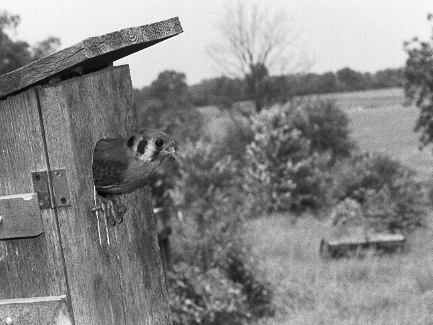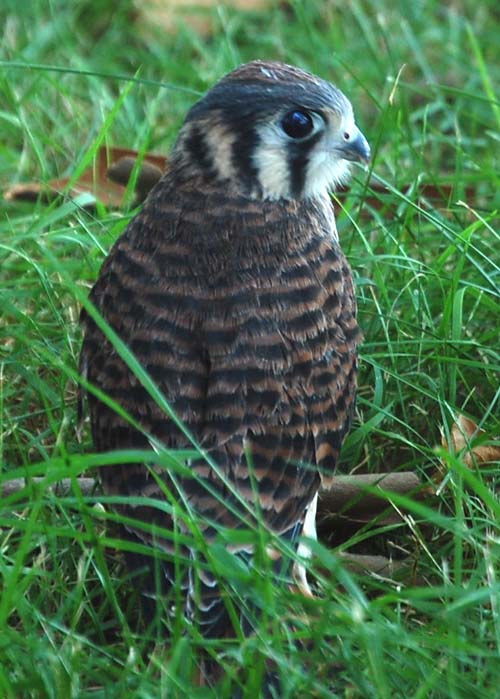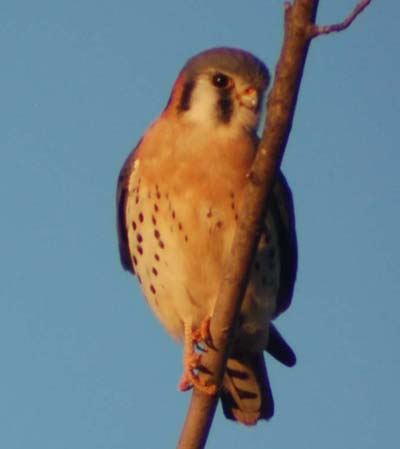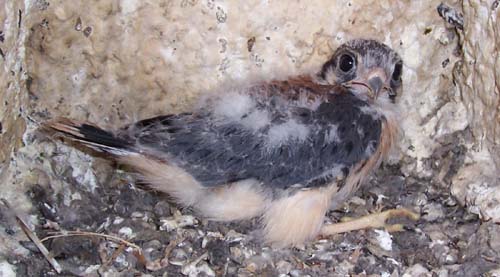
Richard and Diane Van Vleck Personal Pages The Home Habitat |

This smallest of North American falcons is a common resident throughout much of the U.S. It is a bird of open land, frequently using a telephone pole or wire as a hunting perch, where it is often mistaken for a songbird. Once beginning birders learn to recognize this species, they are often amazed at how many can be counted along a few miles of country road. Even so, kestrel populations have declined in some areas. Since they consume primarily insects in the summer, it is possible that the use of pesticides has had an effect on them in recent decades. An even greater problem may be a scarcity of nest sites. Being a secondary cavity nester, the kestrel requires an abandoned woodpecker hole or similar cavity. Luckily, this little falcon will readily utilize man-made nestboxes. Sadly, few people bother to erect larger nestboxes for kestrels and screech owls, perhaps, because they think their chances of attracting these species are small. My experience is quite the opposite, and I would urge anyone who has kestrels hunting nearby to try a nestbox.
 Kestrels require an open habitat where they can locate their prey from above. They most frequently hover or perch 20 to 30 feet above the ground when hunting rodents. In the summer, our pair spend much of their time along the creek, hunting insects and an occasional frog. In years when grasshoppers are abundant, this seems to be their staple food. Only once in the many years that a pair of kestrels have nested in boxes on our property has an individual taken a particular interest in our songbird feeding station. This August, for about one week, Diane or I frequently caught a glimpse of a female darting into or out of a large lilac bush near the feeders. There was no indication that the kestrel was successful in catching a bird, and the feeding birds didn't seem overly concerned, quickly returning to the feeders. This was likely one of this year's young, and it's sudden disappearance at the feeders coincided with the parents' asking all of their young to leave, as they do each year. However, others have had quite different experiences, so keep your kestrel box well away from your feeding station.
Kestrels require an open habitat where they can locate their prey from above. They most frequently hover or perch 20 to 30 feet above the ground when hunting rodents. In the summer, our pair spend much of their time along the creek, hunting insects and an occasional frog. In years when grasshoppers are abundant, this seems to be their staple food. Only once in the many years that a pair of kestrels have nested in boxes on our property has an individual taken a particular interest in our songbird feeding station. This August, for about one week, Diane or I frequently caught a glimpse of a female darting into or out of a large lilac bush near the feeders. There was no indication that the kestrel was successful in catching a bird, and the feeding birds didn't seem overly concerned, quickly returning to the feeders. This was likely one of this year's young, and it's sudden disappearance at the feeders coincided with the parents' asking all of their young to leave, as they do each year. However, others have had quite different experiences, so keep your kestrel box well away from your feeding station.
Male and female kestrels are readily identified by their different markings as well as their difference in size. Falcons, including kestrels, exhibit an uncommon sexual dimorphism in that the female is substantially larger than the male. Juvenile plumage is similar enough to the adult to distinguish the sex of older nestlings. The size difference is also already apparent in nestlings.
During winter, our resident male and female kestrels have little to do with each other, hunting in different areas, and seldom interacting. In spring, a noisy courtship is readily observed. Until the clutch of eggs are laid, the female spends most of her day in or near a large walnut tree about 200 yards from the nestbox. The male now does all the hunting and frequently brings her food. The food exchange always takes place in the walnut tree, and usually on the same branch. The two land beside each other and bow their heads several times before the female takes the food from the male. She then takes the prey to the other side of the tree and he flies off to resume hunting. Both birds also often perch on the same or nearby branches for long periods of time
 Once incubation begins, the male brings food to the nestbox, and also shares in incubation twice each day. Incubation lasts about 30 days. When the young hatch, the female broods continuously for about a week, during which time the male still brings all the food for both the female and the young. Then, the female finally leaves the nest to join in feeding the now ravenous nestlings. She returns to the nest at night to brood the young for several more days. When the young fledge at approximately 30 days, they are coaxed to the creek area, where both parents continue to feed them. For at least several days, the female and young return to the nestbox at night. After two weeks, the young are on their own and must leave the adults' territory. The adults then resume their solitary ways and seldom bring themselves to our attention until early autumn, when migrant kestrels frequently invade their territory. By the onset of winter, territorial disputes have usually been sorted out and kestrels all over the county seem to have fanned out to cover every possible acre of open field and meadow. Kestrels and other raptors are often praised for their ability to devour large numbers of rodents, but, perhaps, the real heros are the millions of meadow voles and white footed mice who unwittingly make the ultimate sacrifice to fuel the fires of our beloved birds of prey. Here, in Maryland, the winters are rather mild and probably not too difficult for the kestrel who has acquired a chunk of prime habitat. But, when severe weather does come and rodents are hiding deep beneath the snow, the lucky little kestrel always has a friend it can turn to - the house sparrow. All creatures have value, and, in the case of the house sparrow, it is kestrel food.
Once incubation begins, the male brings food to the nestbox, and also shares in incubation twice each day. Incubation lasts about 30 days. When the young hatch, the female broods continuously for about a week, during which time the male still brings all the food for both the female and the young. Then, the female finally leaves the nest to join in feeding the now ravenous nestlings. She returns to the nest at night to brood the young for several more days. When the young fledge at approximately 30 days, they are coaxed to the creek area, where both parents continue to feed them. For at least several days, the female and young return to the nestbox at night. After two weeks, the young are on their own and must leave the adults' territory. The adults then resume their solitary ways and seldom bring themselves to our attention until early autumn, when migrant kestrels frequently invade their territory. By the onset of winter, territorial disputes have usually been sorted out and kestrels all over the county seem to have fanned out to cover every possible acre of open field and meadow. Kestrels and other raptors are often praised for their ability to devour large numbers of rodents, but, perhaps, the real heros are the millions of meadow voles and white footed mice who unwittingly make the ultimate sacrifice to fuel the fires of our beloved birds of prey. Here, in Maryland, the winters are rather mild and probably not too difficult for the kestrel who has acquired a chunk of prime habitat. But, when severe weather does come and rodents are hiding deep beneath the snow, the lucky little kestrel always has a friend it can turn to - the house sparrow. All creatures have value, and, in the case of the house sparrow, it is kestrel food.
 Offering mice to kestrels is as simple as offering sunflowers to house finches, and probably of no more value when done on a routine basis. However, there are often a few days in winter when providing a mouse or two may save your kestrels' lives. Waiting out a prolonged winter storm is no picnic when you are half frozen and haven't eaten all day and even the house sparrows have taken refuge in barns. Many birds die during these worst of winter days. In fact, such storms may have an important role in determining population densities and northern range limits for many species.
Offering mice to kestrels is as simple as offering sunflowers to house finches, and probably of no more value when done on a routine basis. However, there are often a few days in winter when providing a mouse or two may save your kestrels' lives. Waiting out a prolonged winter storm is no picnic when you are half frozen and haven't eaten all day and even the house sparrows have taken refuge in barns. Many birds die during these worst of winter days. In fact, such storms may have an important role in determining population densities and northern range limits for many species.
A discarded aquarium with a crack or leak will serve as a kestrel mouse feeder. If at the bottom, the leak is actually an advantage, allowing rain water to drain. Otherwise, if the aquarium is left out when not in use, rain water will collect and freeze, causing more severe cracks. The sides of the aquarium should be no higher than is required to prevent escape of the mice. The lower the sides, the more willing the kestrel will be to drop into it. For this reason, it is best to use a strain of pet store mice rather than wild mice. These strains have been genetically "detuned"and will contentedly wander around the aquarium floor, sniffing and nibbling on food in a manner more typical of livestock than of wild rodents. In contrast, dropping several wild mice into the same aquarium would be comparable to prematurely removing the lid of a popcorn popper.
If you plan to feed your kestrels during severe weather, it is important to teach them to take mice from the feeder beforehand. Placing the feeder below the nest site at any time during the nesting cycle will assure that it is discovered. While it is often written that kestrels prefer insects in the summer, it may be that insects are so abundant and easy to catch while rodents are harder to find in the summer vegetation, that the shift in prey is simply out of convenience. Kestrels have never refused the few mice I have offered at nesting time, and have taken them to the young at least by the third week after hatching. The only time I ever feed heavily during nesting is for several days after neighboring farmers spray their fields, hoping to dilute the poisoned grasshoppers with good clean mouse meat. Incidentally, I have no real evidence that agricultural spraying harms kestrels. Several years ago an entire brood died within 48 hours of spraying adjacent to our property in a field heavily hunted by our kestrels. However, I wasn't routinely checking nests that year and there are many other possible reasons for their deaths, with the timing being mere coincidence.
When placing the kestrel feeder, thought should be given to the comfort of the prey. In hot weather, either choose a shaded location or cover a side of the aquarium to provide shade and put mice out in the cooler part of the day. Also, kestrels are most active in late afternoon and mid-morning. DO NOT USE ALBINO MICE! They cannot tolerate sunlight and seem more stressed from other environmental changes, as well. Always provide water and food in the aquarium. Placing the food in the center of the enclosure will cause the mice to spend more time there, where they are more visible from above. In very cold, clear weather, the glass sides of the aquarium make a quite comfortable environment, many degrees warmer than the outside temperature. Even so, the mice should be rotated to avoid overexposure. When you are trying to attract kestrels to your feeder in warm weather, mice may be left out for several hours, however, during severe weather, 15 minutes may be too long. The better you have conditioned your kestrels to expect mice in the aquarium, the more efficient your emergency feeding program will be. The most likely problem you will encounter with a kestrel feeder is that a cat will discover it. If it is your cat, you can lock it on the porch or in the house while the mice are out. If it is the neighbor's cat, perhaps they will do the same. If it is a feral cat, it should be taken to the pound. You'll be doing your songbirds a great favor.
| barn owl | American kestrel | purple martin | barn swallow | Eastern bluebird |
| tufted titmouse | Eastern phoebe | yellow shafted flicker | tree swallow | chimney swift |
| house wren | big brown bat | Carolina wren | brown thrasher | catbird |
| cedar waxwing | Northern mockingbird | |||
| Yellow warbler | Acadian flycatcher | |||
email richard@americanartifacts.com